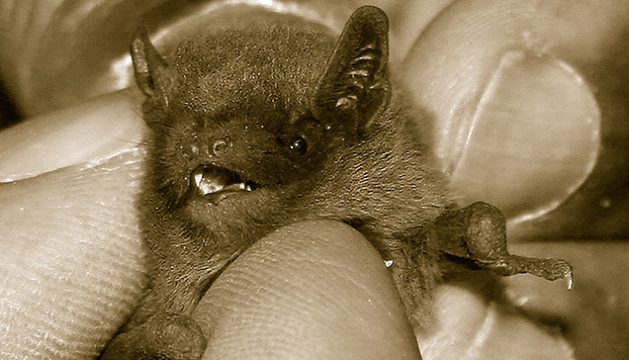10
Dec
New Test Will Help Researchers Understand Pesticide Threats to Wild Bat Populations

(Beyond Pesticides, December 10, 2020) A new test developed by a team of Mexican and Canadian scientists will help field researchers detect early warning signs of pesticide exposure in wild bat populations. There are relatively few studies on the effects of pesticide exposure on bat populations, the authors note in a study published in Environmental Toxicology and Chemistry, but there is considerable need to monitor the health of these important species. “Access to resources might be limited for institutions with less financial support such as conservation NGOs and researchers in developing countries,” said co-author Natalia Sandoval-Herrera, PhD. “The use of early warning biomarkers such as genotoxic effects are most needed in these regions, where the use of pesticides is extensive and there is high biodiversity.”
The test in question is referred to as a micronucleus test. Although it does not measure the level of pesticide contaminating a bat’s body, it can assess genotoxicity (the effect of pesticides and other chemical agents that damage genetic information in a cell). This is done by taking blood samples of bats, and testing for the presence of micronuclei formation, which are materials in blood that contain damaged chromosomes not incorporated into a cell after cell division. “This test as a logistically simple, sensitive, and robust method for biomonitoring genotoxic effects in wild bat populations,” Dr. Sandoval-Herrera explains.
The technique was trailed in Mexico, using 35 bats from 3 different colonies in Colima and Jalisco in the western part of the country. Results showed that bats roosting in caves with higher levels of agricultural production (53%) had higher levels of micronucleus detection than those found in a less disturbed site (15%). As a result, the authors conclude that the testing is likely to be an effective, inexpensive approach to biomonitoring bat populations.
Rampant declines in biodiversity underline the need for quick and simple field testing of wild bats, which provide critical ecosystem services for civilization. A study published in April 2020 found that bats provide “important pest suppression services” in managing insects that feed on crops, such as the pink bollworm. “Big” and “little” brown bats, most common species in the US, consume 3,000–7,000 insects per night. In some regions, bats also provide fertilization through guano deposits; notably, there is a thriving commercial fertilizer industry that uses guano as a primary ingredient. A 2011 study in the journal Science found that the value of bats’ pest-control services to agricultural operations in the US ranges from $3.7 billion to $53 billion per year.
What little research that has been conducted on the harm pesticides cause to bats shows significant cause for concern. Agricultural pesticide use results in a large proportion of a bat’s insect diet being contaminated with highly toxic chemicals. Bats are particularly sensitive to pesticides that bioconcentrate in fat (lipophilic pesticides); they develop large stores to use while migrating or hibernating, and high concentrations of toxic pesticides in this fat can result in significant poisoning as the body burns it off.
Adding to the dangers pesticide pose is the threat of the epidemic disease White Nose Syndrome. The cold-loving fungus thrives on hibernating bats. Populations of several North American species, including the little brown bat, the Northern long-eared bat, and the tri-colored bat, have declined by over 90% since the disease was first detected in 2006 from a cave in New York State.
Despite the unique ways in which pesticides harm bats, the U.S. Environmental Protection Agency (EPA) does not evaluate a pesticide’s effect on bats prior to registration. The widespread use of testing systems like the one discussed in the present study should help show the extent of toxic contamination in bat populations, and build pressure for regulatory action. But all this presumes an EPA that not only tracks and follows the latest science, but acts upon it.
The importance of bat species and their services cannot be understated. Bats are the only nocturnal insect predator in the U.S., and are one of two primary nocturnal pollinators (along with moths) — important roles for night-flowering plants and for farmers. The two species of brown bats (the “big” and the “little”) most common in the U.S. are voracious, consuming 3,000–7,000 insects per night. In some regions, these creatures also provide fertilization through deposits of their guano; notably, there is a thriving commercial fertilizer industry that uses guano as a primary ingredient.
Because bats are unusually long-lived for animals their size — lifespans range from 20 to 40 years — their bodies can accumulate pesticide residues over a long period, exacerbating adverse effects associated with those pesticides that can accumulate in fatty tissue. Also, during migrations or winter hibernation (when their fat stores are metabolized), bats’ consumption of large volumes of pesticide-contaminated insects can mean that these compounds may reach toxic levels in their brains — making them more susceptible to WNS. Bats also tend to have only one offspring each year, making them vulnerable to the population impacts of negative reproductive effects caused by pesticides, because low reproductive rates require high adult survival rates to avoid population declines.
Beyond Pesticides advocates for pollinator species, including bats. There are many ways that the public can support these inky and slightly chimerical creatures, and protect them from pesticides. Learn more at Beyond Pesticides’ pollinator protection page, Hedgerows for Biodiversity fact sheet, and alternatives to spraying page.
We need to blaze a new path for pesticide regulation in the U.S., one that protects pollinators, biodiversity, and the wider environment. Join Beyond Pesticides in urging President-elect Biden to take the EPA in a new direction, shifting away from toxic production systems and toward an approach that embraces the agency’s namesake of environmental protection.
For more information on the dangers pesticides pose to the web of life, see Beyond Pesticides Biodiversity webpage.
All unattributed positions and opinions in this piece are those of Beyond Pesticides.
Source: Phys.Org (press release), Environmental Toxicology and Chemistry










